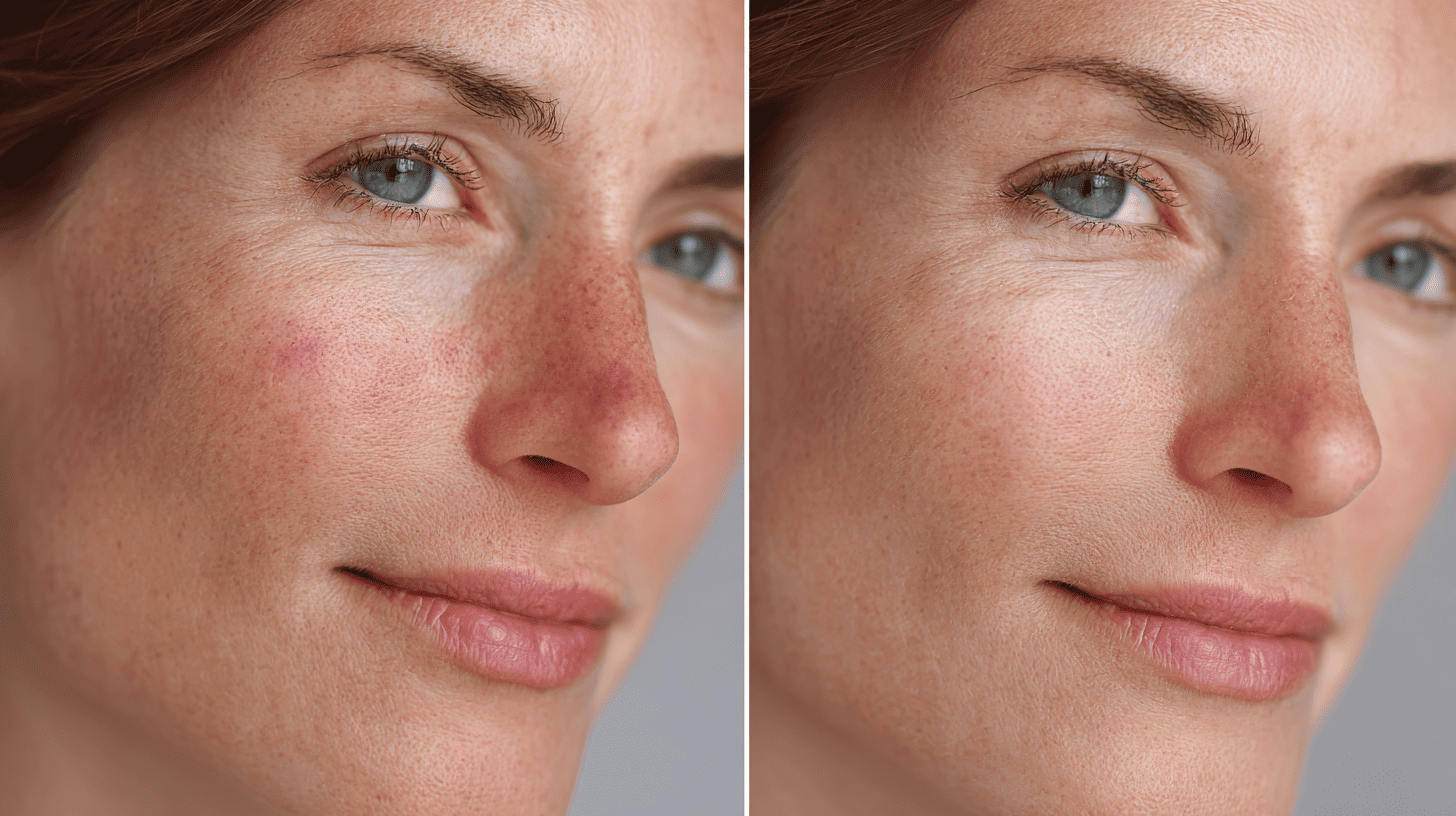Want to know what azelaic acid before and after results really look like? This gentle but powerful ingredient tackles redness, dark spots, and breakouts without harsh side effects.
The changes happen slowly – most people see clearer, calmer skin between six and twelve weeks.
Real progress takes patience, but the photos and timelines ahead show exactly what happens from day one to month three.
Understanding how this skincare favourite works makes the wait easier. Get ready to see realistic results on different skin concerns and learn what to expect at every stage of using this ingredient.
What Is Azelaic Acid & How Does It Work?
Azelaic acid is a natural dicarboxylic acid found in grains like barley and wheat. It helps the skin by acting as an anti-inflammatory, antibacterial, and keratolytic ingredient, gently removing dead skin and unclogging pores.
It’s often used to calm rosacea, fade dark spots from hyperpigmentation, and treat mild acne.
The ingredient works slowly but steadily – most people start noticing improvements between six to twelve weeks. Studies show it can lower rosacea lesion counts and reduce redness without harshness.
It doesn’t bleach skin or thin it; instead, it evens tone while keeping the barrier strong and irritation low.
Why Azelaic Acid Before and After Results Are So Impressive
Azelaic acid works in three ways: calming inflammation, stopping acne-causing bacteria, and fading excess pigment in the skin.
Dermatologists value it for restoring balance in sensitive or reactive skin without causing peeling or burning. It reduces rosacea redness triggers and slows melanin overproduction, brightening uneven areas.
Scientifically, it inhibits the enzyme tyrosinase, which is responsible for the production of dark pigments. Over time, this triple action makes skin appear clearer, smoother, and more even.
It’s gentle enough for daily use yet effective enough for visible change when used with patience and consistency.
Azelaic Acid Rosacea Before and After

Azelaic acid is widely recommended by dermatologists for managing rosacea due to its anti-inflammatory and antibacterial properties.
Within the first few weeks, it works to reduce skin sensitivity and discomfort, though visible redness may take longer to improve.
Around week four, redness typically begins to fade, and flare-ups become less frequent. By week eight, the skin’s texture looks smoother, and inflammatory bumps are visibly reduced.
After twelve weeks of consistent use, most users see fewer reactive flare-ups, calmer skin, and a decline in overall redness intensity.
Using a 15% azelaic acid gel daily, under a dermatologist’s supervision, supports long-term maintenance and comfort for rosacea-prone skin.
Hyperpigmentation Azelaic Acid Before and After

Azelaic acid is a trusted option for treating hyperpigmentation, melasma, and dark spots caused by acne or sun exposure.
The ingredient works by reducing excess melanin production beneath the surface, gradually lightening uneven patches.
In the first few weeks, improvement is subtle, often evident in smoother, softer skin. By week six, dark marks typically begin to fade, and around week twelve, the overall tone appears more even and radiant.
Consistent use alongside daily sun protection prevents new discoloration and maintains brightness. Over time, results develop steadily, offering a noticeable yet gentle improvement in skin clarity and balance.
Week-by-Week Timeline: What to Expect from Day 1 to Month 3
Everyone’s skin adjusts differently to azelaic acid, but the changes usually follow a steady pattern. The first few weeks focus on balancing the skin’s texture, while the later weeks reveal clearer, calmer, and more even-toned skin.
-
Weeks 1-4: Skin begins adjusting to the product. There might be light tingling or a short purging phase as clogged pores clear. The texture feels smoother, and the redness is starting to fade.
-
Weeks 5-8: Skin tone looks more uniform with fewer flare-ups. Red marks after acne or irritation begin to fade slightly. The surface feels calmer and less reactive to daily stressors.
-
Weeks 9-12: Pigmentation softens and overall clarity improves. Pores appear more refined, and the skin gives off a healthy, even glow. Continued use and sunscreen make results more visible and lasting.
Progress with azelaic acid rarely happens overnight, yet each phase brings healthier texture and tone. It’s the quiet, consistent improvements that show just how well the ingredient works with patience and care.
Who Will Benefit Most and Who Should Be Cautious?
Azelaic acid fits many skin types because it works quietly but effectively on redness, breakouts, and uneven tone.
Still, not every skin concern responds the same way, and a slow, monitored approach ensures the ingredient delivers comfort, not irritation.
| BEST SUITED FOR | THOSE WHO SHOULD BE CAUTIOUS |
|---|---|
| Mild‑to‑moderate rosacea with redness and bumps | Severe rosacea or visible blood vessels (telangiectasia) – the effect on broken capillaries may be limited |
| Hyperpigmentation, melasma, or dark marks after acne | People prone to burning, itching, or flaking after actives – patch test before use |
| Acne‑prone or combination skin needing a non‑drying exfoliant | Users already layering strong actives like retinoids, glycolic, or salicylic acid |
| Sensitive skin needing a calm brightening option | Very reactive or allergy‑prone skin – apply gradually and with moisturizer |
| Those who prefer pregnancy‑safe actives or dermatologist‑approved options | Anyone unsure about concentration strength (10–20%) – seek professional guidance |
When used with patience and balance, azelaic acid brings steady, healthy changes to the skin. Taking a few precautions – like spacing strong actives and patch testing first – keeps the routine smooth and irritation‑free.
Side-Effects, Setbacks & What to Know

Azelaic acid offers many skin benefits, but it’s normal to experience some initial reactions. Knowing what to expect helps keep things manageable and makes it easier to stick with the routine.
- Redness calmed down, skin felt smoother, and old marks began to fade.
- The first 1–2 weeks brought mild stinging and dryness, especially without moisturiser.
- Overuse caused slight peeling or tightness around sensitive areas.
- Some with rosacea saw brief flare-ups before improvement.
- Begin slowly (every other day), moisturise well, and avoid strong acids or retinoids early to reduce side effects.
Short breaks, gentle hydration, and patience made all the difference. Once the skin had settled, azelaic acid’s results became both clearer and easier to maintain.
Summing It Up
Seeing azelaic acid before and after photos proves that slow and steady wins when fixing redness, acne marks, and uneven tone.
The path from week one to twelve shows real change – calmer skin, fewer dark spots, and a healthy glow that grows over time. Stick to the routine, use sunscreen daily, and give it three months for results.
Patience makes all the difference as skin starts to look clearer and more balanced. Have questions about starting azelaic acid or want to share your own progress?
Drop a comment below – your experience might help someone else take the first step!







